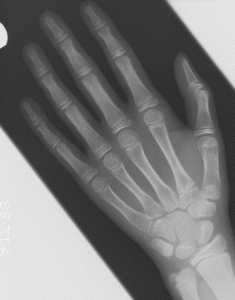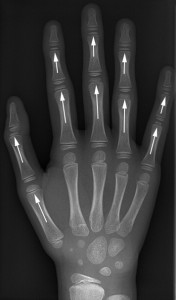The prevalence of pseudoepiphyses in the metacarpals of the growing hand
“Normally the metacarpals have an epiphysis at one end — distally for the second to fifth and proximally for the first. Pseudoepiphyses are notches or clefts that occur at the non-epiphyseal ends of bones where an epiphyseal plate would be expected and are common incidental findings in the metacarpals of the growing hand. We aimed to identify the prevalence of pseudoepiphyses on serial radiographs of 610 healthy asymptomatic children. Pseudoepiphyses in the form of notches or clefts were common, identified most often in the second metacarpal (15.25%), fifth metacarpal (7.21%), and third metacarpal (0.49%). Complete pseudoepiphyses, in which the cleft extended across the full width of the metacarpal, were seen in the first metacarpal (1.97%) and the second metacarpal (1.31%). Pseudoepiphyses are a normal variant of metacarpal ossification and should not be confused with fractures in skeletally immature patients. ”
<-Is there any way to form psueodoepiphyses to grow taller? Normally in long bones there are two epiphysis but in the finger bones there is only one epiphyseal plate except a psuedoepiphysis is a secondary growth plate like that of a normal long bone.
 One of these finger bones has a second epiphyseal plate that’s a psuedoepiphysis.
One of these finger bones has a second epiphyseal plate that’s a psuedoepiphysis.
“supernumerary epiphyses appear as a separate node of ossification in an island of hyaline cartilage.”
“three basic patterns of formation [of pseudoepiphysis formation]. In the first, a central osseous bridge extends outwards from the metaphysis and then expands into a ‘mushroom-like’ osseous structure. The circular notch proximal to this structure gives the bone the appearance of an epiphysis. If this notch is displaced to one side, it can give the appearance of a cleft or partial pseudo-epiphysis. The other two patterns recognized were of an abnormal peripheral osseous bridge, creating an eccentric notch in the bone, and of multiple abnormal osseous bridging points. In each situation, the area that appeared to be a ‘pseudo-physis’ lacked typical cell columns and these were incapable of significantly contributing to the postnatal growth of the involved bone.”<-Can we create these osseus bridges?
Complete pseudoepiphyses with associated enhanced growth in hands and feet: a report of 2 siblings-case report.
“We present 2 siblings with multiple complete pseudoepiphyses in their hands and feet with associated symptomatic enhanced growth. Physical examination of the 6-year-old boy revealed long slender fingers and hyperplastic great toes. Radiography showed complete pseudoepiphyses in the first metacarpals, proximal and middle phalanges of the hands, and proximal phalanges of the feet. The patient’s younger brother had a similar phenotype with slightly milder functional complaints. Genetic analysis did not reveal an underlying syndrome in these siblings. ”
 Notice each finger bone has a second growth plate. Psuedoepiphysis’ do not always increase growth. Since many things do not show up in x-ray’s maybe what appeared to be psuedoepiphysis’ were actually something different entirely which would not show up on x-rays.
Notice each finger bone has a second growth plate. Psuedoepiphysis’ do not always increase growth. Since many things do not show up in x-ray’s maybe what appeared to be psuedoepiphysis’ were actually something different entirely which would not show up on x-rays.
That these siblings both developed pseudoepiphysis’ makes a mechanical means of inducing psuedoepiphysis’ less likely but it’s still a possibility if they performed the same activities especially as they did not find a genetic link. Although they could’ve missed it. The two siblings were 5 and 6 year old boys.
